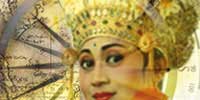|
The lifestyles of Balinese people is expressed in their
dance. Not only do we learn about the Balinese religion
from their dance creations but also we can come to understand
the flow of cultural events and activities that belong
to everyday life. We can discover Balinese attitudes,
how they look at nature, and how they regard their fauna
and flora.
The very essence of the Balinese culture is dance and
drama, which is performed during temple festivals and
in ceremonies. The dances performed in hotels is a small
fraction of what Balinese dance has to offer.
Balinese dance goes as far back as Balinese written history
with much of the heritage originating from Java. Ironically,
as a result of the Islamisation of Java, the Javanese
culture has disappeared but has still survived in Bali
and has become part of classical Balinese culture.
Balinese dance cannot be separated from religion. Even
the dances for the tourists are preceded by many dancers
praying at their family shrine for taksu (inspiration)
from the gods.
Dance fulfils a number of specific functions: It may be
a channel for visiting gods or demons, the dancers acting
as a sort of living repository. It may be as a welcome
for visiting gods. It may be entertainment for visiting
gods.
The typical posture of Balinese dance has the legs half-bent,
the torso shifted to one side with the elbow raised and
lowered in a gesture that displays suppleness of the hands
and fingers. The torso is shifted in symmetry with the
arms. If the arms are to the right, the shifting is to
the left and vice-versa.
The Ramayana
The story of the Ramayana greatly inspires the Balinese.
Many of their dances are based on this great story which
is often depicted in a ballet.
The Balinese version differs from the Indian Version.
It is told that Rama, as the first son in a family, was
the heir to the Ayodya kingdom but the king's second wife,
through her treachery forced the king to crown her own
son as the King of Ayodya and asked him to send Rama and
his wife into exile.
Because he respected his father, Rama went with his wife
called Sita and his beloved younger brother, Laksmana
into a forest called Dandaka. Usually the first act of
the ballet depicts Rama and entourage in the heart of
the Dandaka forest.
Rahwana, the evil King of Alengka, enchanted by the beauty
of Sita, wanted to have her as his concubine. He sent
one of his knights, Marica, to temp Sita by transforming
himself into a golden deer. Sita, captivated by her curiosity,
asked her husband to catch the golden deer.
The next act explains how Rama succeeds in hunting the
golden deer but as his arrow struck the golden deer it
transformed back into Marica. Meanwhile Sita heard a distant
cry for help. Laksmana, who had been asked by his brother
to look after his sister-in-law, tried to explain to her
that the cry sounds very suspicious. But nevertheless,
Sita was convinced that someone was in need of help. So
she sent Laksmana to look for this person and to help
whoever it is. In his desperate attempt, Laksmana asked
Sita, no matter what would happen, to stay inside the
guarding circle that he created.
Rahwana, knowing that Sita was protected by the circle
transforms himself into an old priest. He approaches Sita
and asks her for a drink. Sita, without hesitation, extends
her hands beyond the circle to hand him the water. Rahwana
takes the advantage, snatches her hand and takes her to
his palace in Alengka.
On the way, Rahwana encounters a mighty eagle Jatayu.
By every means possible, Jatayu tries to rescue Sita from
the evil king but fails and is killed by Rahwana.
Rama and Laksmana find the dying Jatayu who tells them
the whole story of what had happened to Sita.
In his attempt to release his wife, Rama seeks the help
from Hanoman and his monkey soldiers. Hanoman finds Sita
in the palace's garden. She had been asked by Rahwana
to marry him but she would rather die. Hanoman convinces
Sita that he is Rama's messenger and talks of a plan.
Rahwana catches Hanoman and burns his tail but in so doing,
set fire to the palace's' gardens. The pyrotechnics can
be very impressive.
In the last act, Rama and his troops are depicted attacking
Rakhwana's palace. Finally Rama manages to kill Rahwana
and therefore takes his wife back to his country.
The abridged version ends here but if you see paintings
in Kamasan style based on the Ramayana story, you would
notice that in the last of serialised paintings, Sita
had to prove she was still pure, and had not been tainted
by Rahwana, by plunging herself into a fire. Because of
her faith in her husband, God saved her from the fire
and she lived happily ever after with Rama.
The Indian version reveals a very different ending with
Sita saved by Mother Earth, never returning to her husband.
The Welcome Dance - Tari Panyembrama
The Panyembrama is probably the most popular Balinese
social dance. In keeping with its meaning in the Balinese
Language, Panymebrama is frequently staged to welcome
guests of honour who are making a visit to this islands
of the Gods.
Four or eight young girls bearing a bokor, a heavily
engraved bowl made from silver or aluminium, laden with
flowers, dance expressively to the accompaniment of vibrant
gamelan music.
During the dance, the flowers are scattered over the guest
or audience as an expression of welcome. The Panymebrama
has taken many of its movements from temple dances, such
as the Rejang Dance, Pendet and Gabor, which are considered
sacred and performed exclusively for God. There is an
analogy between the secular Panymebrama and the religious
temple dances, as all these dances are welcoming dances,
the difference being in the place in which they are stage.
The Tari Panymebrama comes under the Balinese classification
of Legong (individual dances), because it has no
connection with other dances, has no story and was specifically
created for welcoming and entertainment purposes.
The hospitality and friendliness conveyed through the
smiles of the Panymebrama girls, charms the audience and
so is very fitting as an opening for a show, etc.
The Yudapati Dance
Yudapati is a dance which depicts a male character but
is performed by female dancers. The word Yudapati is derived
from Yuda which means war and Pati which means death.
The dance represents the kamikaze warrior in defending
the truth. The dance was created in 1987. It is based
on the Baris dance.
The dancer wears typical male attire, headcloth, shirt,
carved leather belt and other jewellery. The reason for
a male being performed by a female is that the choreographer
wishes to reveal all the subtle gestures and movements
in the dance by using the flexibility of a woman's body.
Male dance performed by females is called Bebancihan.
A number of other dances have been created in the s style,
such as Margapati, Trunajaya, Prawireng Puti, Wiranata
and Danur Dara. They require masculine interpretation
and expression which is quite hard for female dancers.
Yudapati dance was originally performed for religious
purposes but nowadays is performed regularly as a tourist
attraction in some restaurants.
The Ghopala Dance
This dance provides the audience with an interesting insight
into the lives of people who live in a simple and pure
manner in an environment of blissful tranquillity. This
dance originated in 1984 and usually performed by five
boy dancers. The characters of the Ghopala dance are especially
funny and will draw laughter from the audience.
The Ghopala theme depicts the world of children herdsmen
who gleefully meet and play along the boundaries of rice
fields while tending their cows. Their lives are filled
with happiness as they dance and play in a way which highlights
their individual characters. They never tire of their
duties as herdsmen, faithfully defending the lives of
their cattle. Thus the audience are transported to a distant
time when people lived in peace and contentment, an age
which had not yet become influenced by the bustle of business
which now constantly steals our time.
The Semarayana Dance
As we know, there exists many art forms such as music,
painting, poetry, drama, sculpture, etc. and, of course,
dancing is yet another and is a popular form of expression.
Artists will take a certain aspect of a medium, build
on it to form another. This is the case of the Semarayana
dance developed in 1994 as a subject for a thesis submitted
by Ms Ni Nyoman Sri Armita to the Indonesian Arts Academy
of Denpasar for her graduation.
The main character is Dewi Chandra Kirana, a princess
from the kingdom of Daha who disguised herself as a male
youth so she could venture out and seek her beloved who
had disappeared without a trace.
With shoulder length hair, commonly used centuries ago
throughout Java and Bali, the princess was unrecognisable
as a female. The symbol of manhood which fooled people
she met on the road, was the use of the Balinese male
headgear called the Destar. It is made from material
that wraps around the head and has an artistic formation
of bunched material at the front.
Balinese males still use the destar when attending ceremonies.
The feature of the destar is the decorative use of gold
lines.
Dewi meets her beloved but due to her disguise and the
fact that he is partly obscured when they meet, a fight
develops. In the ensuing melee, the princess's destar
is knocked from her head and her sweetheart, Raden Inu
Kertapati, recognises her and rushes to her side to embrace
her.
And, of course, they lived happily ever after.
The Barong Dance
The are several versions of the Barong Dance, as Bali
has an abundance of myths and legends. There is Barong
Ket, Barong Asu (Dog Barong), Barong Macan (Tiger Barong),
Barong Bangkal (Pig Barong), Barong Gajah (Elephant Barong)
and others.
One of the well known stories on which the Barong Dance
is based, is the Kunti Seraya. The plot is very intriguing,
showing the effect of the Gods intervention upon the people
through supernatural powers.
It is told that Dewi Kunti, from the royal family of Hastinapura,
was very ill. As a devotee of the Goddess Durga, she seeks
help, however, the Goddess tells her that the price of
health is her own son, Sahadewa. It seems that the Goddess
fancied Sahadewa's young and luscious flesh for her dinner.
Dewi Kunta recovers from her illness and it is time to
pay the price. She regrets her decision to pay the price
but a promise is a promise. One of the Goddess's followers
put her into a trance and enters her body. She becomes
a terrifying creature and unconsciously beats Sahadewa
mercilessly. She then takes him to an unpenetratable jungle
and ties him to a tree. Later Sahadewa is given immortality
by God and she overcomes the wrath of the Goddess and
she is able to release her son.
The Sanghyang Jaran Dance
The unique feature of the Sanghyang Jaran dance is the
courage of the dancers who in a state of Kesurupan
or trance, calmly step and trample on red hot coals just
as if they were walking in cold water.
This dance is believed to have the power to invite the
gods or sacred spirits to enter the body of the dancers
and put them in a state of trance. It dates back to the
ancient Pre-Hindu culture, a time when the Balinese people
strongly believed that a dance could eliminate sickness
and disease. The is dance is usually performed in the
fifth or sixth month of the Balinese traditional calendar
as it is believe that during these particular months,
the Balinese are vulnerable to all kinds of illnesses.
The War Dance - Gebug Ende
The Gebug Ende is a combination of dance and trial of
prowess. It is usually performed by two to sixty male
dancers who dance and fight on stage in pairs. Each dancer/fighter
carries a one and a half metre long rattan stick as as
a weapon and a shield called an ende. During the
performance the two men try to beat one another with the
stick while using the ende to protect themselves. The
dance is called Gebug Ende as it literally means
beating the ende or shield. One cannot afford to
make mistakes in this dance as otherwise injury results.
The Gebug Ende is quite unique as it has certain rules
that have to be followed by the participants. Led by a
jury, this dance starts with two dancers, while the rest
sit in a circle, cracking jokes and singing, while waiting
their turn. The jury decide which of the two contestants
loses the game and has to leave the stage. Then they will
call the next men to the stage. This continues until all
have had a turn. Sometimes the fight becomes very fierce
and the dancers get thrown of the stage from the blows
of the rattan stick. Bruises and wounds are common in
this ritual.
Legong Trunajaya - The dance of love and emotions
The Trunajaya dance describes the emotions of a young
man through love and passion. The dance movements reflect
the theme of courtship and love.
Truna meaning 'single' and jaya meaning 'to win' immediately
gives an understanding of the dance. Ironically, the dancer
are young women who take on the role of young men. The
women wear a 'destar' normally worn by men and an unusual
loin-cloth called a 'kancut'. The Trunajaya is normally
danced by a single female but sometimes two, dancing together
in synchronous movements and to the mesmorotic sounds
of the 'Gong Kebyar', a fast, rhythmic beat which goes
in harmony to the dance. The dance was created by Wayan
Wandres, from Singaraja, Northern Bali.
|







